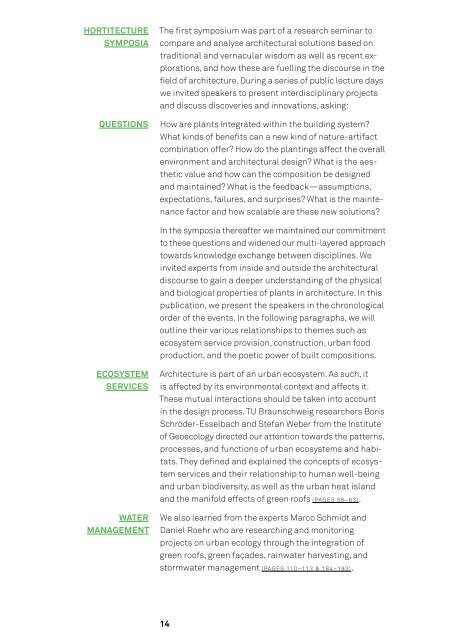HORTITECTURE The Power of Architecture and Plants
ISBN 978-3-86859-547-5 https://www.jovis.de/de/buecher/product/hortitecture.html
ISBN 978-3-86859-547-5
https://www.jovis.de/de/buecher/product/hortitecture.html
You also want an ePaper? Increase the reach of your titles
YUMPU automatically turns print PDFs into web optimized ePapers that Google loves.
<strong>HORTITECTURE</strong><br />
SYMPOSIA<br />
QUESTIONS<br />
<strong>The</strong> first symposium was part <strong>of</strong> a research seminar to<br />
compare <strong>and</strong> analyse architectural solutions based on<br />
traditional <strong>and</strong> vernacular wisdom as well as recent explorations,<br />
<strong>and</strong> how these are fuelling the discourse in the<br />
field <strong>of</strong> architecture. During a series <strong>of</strong> public lecture days<br />
we invited speakers to present interdisciplinary projects<br />
<strong>and</strong> discuss discoveries <strong>and</strong> innovations, asking:<br />
How are plants integrated within the building system?<br />
What kinds <strong>of</strong> benefits can a new kind <strong>of</strong> nature-artifact<br />
combination <strong>of</strong>fer? How do the plantings affect the overall<br />
environment <strong>and</strong> architectural design? What is the aesthetic<br />
value <strong>and</strong> how can the composition be designed<br />
<strong>and</strong> maintained? What is the feedback—assumptions,<br />
expectations, failures, <strong>and</strong> surprises? What is the maintenance<br />
factor <strong>and</strong> how scalable are these new solutions?<br />
In the symposia thereafter we maintained our commitment<br />
to these questions <strong>and</strong> widened our multi-layered approach<br />
towards knowledge exchange between disciplines. We<br />
invited experts from inside <strong>and</strong> outside the architectural<br />
discourse to gain a deeper underst<strong>and</strong>ing <strong>of</strong> the physical<br />
<strong>and</strong> biological properties <strong>of</strong> plants in architecture. In this<br />
publication, we present the speakers in the chronological<br />
order <strong>of</strong> the events. In the following paragraphs, we will<br />
outline their various relationships to themes such as<br />
ecosystem service provision, construction, urban food<br />
production, <strong>and</strong> the poetic power <strong>of</strong> built compositions.<br />
ECOSYSTEM<br />
SERVICES<br />
WATER<br />
MANAGEMENT<br />
<strong>Architecture</strong> is part <strong>of</strong> an urban ecosystem. As such, it<br />
is affected by its environmental context <strong>and</strong> affects it.<br />
<strong>The</strong>se mutual interactions should be taken into account<br />
in the design process. TU Braunschweig researchers Boris<br />
Schröder-Esselbach <strong>and</strong> Stefan Weber from the Institute<br />
<strong>of</strong> Geoecology directed our attention towards the patterns,<br />
processes, <strong>and</strong> functions <strong>of</strong> urban ecosystems <strong>and</strong> habitats.<br />
<strong>The</strong>y defined <strong>and</strong> explained the concepts <strong>of</strong> ecosystem<br />
services <strong>and</strong> their relationship to human well-being<br />
<strong>and</strong> urban biodiversity, as well as the urban heat isl<strong>and</strong><br />
<strong>and</strong> the manifold effects <strong>of</strong> green ro<strong>of</strong>s (PAGES 58–63).<br />
We also learned from the experts Marco Schmidt <strong>and</strong><br />
Daniel Roehr who are researching <strong>and</strong> monitoring<br />
projects on urban ecology through the integration <strong>of</strong><br />
green ro<strong>of</strong>s, green façades, rainwater harvesting, <strong>and</strong><br />
storm water management (PAGES 110–113 & 184–193).<br />
14


















